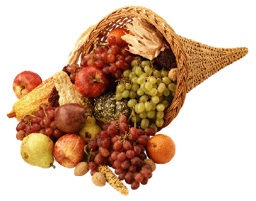
Cicero said that “gratitude is not only the greatest of virtues, but the parent of all the others.” The English preacher John Henry Jowett wrote that “every virtue divorced from thankfulness is maimed and limps along the spiritual road.” And according to Aseop Fables, “gratitude is the sign of noble souls.” A dear professor of mine just acknowledged a thank-you note I sent him and told me that “gratitude is the sign of maturity and wisdom.”
I don’t feel like I’m very good at gratitude. This virtue comes hard to a depressive whose first thoughts are seldom positive. It has only been with much work and lots of practice that I have been able to cultivate gratitude and be genuinely thankful. Here are 12 techniques I use to help me get to the parent of all virtues.
1. See with the heart.
One of my very favorite quotes is from Antoine de Saint-Exupery’s “The Little Prince”: “It is only with the heart that one can see rightly, what is essential is invisible to the eye.” Every time I throw myself into a tizzy because things aren’t going as expected, or as I projected on my Excel spreadsheet for the year 2020, I have to remind myself that I’m looking with the wrong instruments: I need to go back and tell my heart to get some guts and speak up to my head because it’s starting to listen to my eyes again.
2. Change your language.
Learning how to see with the heart–shifting perspectives ever so slightly–is easier once you learn how to talk to yourself and to others. Dan Baker, Ph.D., writes in “What Happy People Know”: “Just as changing your life can change your language, changing your language can change your life.” I do a lot of self-bashing, and when I’m in the middle of a rant, I’m not able to be thankful. According to Baker, recent research has actually proved that: it’s impossible to be simultaneously in a state of appreciation and fear, which is why gratitude and appreciation are antidotes to fear. Moreover, the words I speak to myself and to others really do alter my perception of the world. But when I can recognize the toxic self-talk and change my choice of words, the seeds of gratitude can grow.
3. Get a gratitude partner.
Shifting perspectives–seeing that the cup you thought had one teensy drop is actually two-thirds full–and communicating with new language takes time, discipline, and practice. Just like working out. So it makes sense that a gratitude buddy might help you stay in line, just like your running partner does, or, well, is supposed to. Because, come on, who really wants to wake up at 5:30 in the morning on a dark, cold morning and jog around town, right? Only those who are training for the Olympics, exceptionally disciplined, or have work-out partners who will yell and get even if they are stood up.
4. Remember.
“Gratitude is the heart’s memory” says the French proverb. Therefore, one of the first steps to thankfulness is to remember… to remember those in our lives who have walked with us and shown kindness. I have been extremely fortunate to have so many positive mentors in my life. For every scary crossroad–when I was tempted to take a destructive path and walk further away from the person whom I believe I was meant to become–I met a guardian, a messenger, to lead me out of the perilous forest.
5. Keep a gratitude journal.
Gratitude can do more than make you smile. Research conducted by psychologist Robert Emmons at the University of California at Davis, author of “Thanks! How the New Science of Gratitude Can Make You Happier,” has found that it can also improve your health: raise energy levels, promote alertness and determination, improve sleep, and possibly relieve pain and fatigue. Emmons maintains that writing in a gratitude journal a few times a week can create lasting effects.
6. Write a thank you letter.
Another gratitude exercise suggested by Dr. Emmons, known as “the father of gratitude” in the psychology world, is to compose a “gratitude letter” to a person who has made a positive and lasting influence in your life. Emmons says the letter is especially powerful when you have not properly thanked the person in the past, and when you read the letter aloud to the person face to face.
7. Make a gratitude visit.
Emmons encourages folks to read their letters aloud in person. But I like to go free style. I just show up, usually to a high school or college classroom, and I tell the students what a difference in my life their teacher has made, that I hope that they know how lucky they are to be learning from such an exceptional person, and to be sure to take lots of notes because chances are that they won’t throw out their notebooks after the course is over.
8. Start a gratitude club.
This sounds like an idea for those with, well, lots of time on their hands. But I’m only suggesting it because it works. Last year, Group Beyond Blue held four “self-esteem forums,” where we got online at a specific time, and were each assigned one person to whom to write a warm-fuzzy letter. A few people visited the thread, just curious about what we were up to, and wept after reading some of the letters.
In his book, “Authentic Happiness,” Martin Seligman, Ph.D., the father of the positive psychology movement, describes the dramatic impact of “Gratitude Night,” where class members bring a guest who had been important in their lives but whom they hadn’t thanked properly. Each member of the class presents a testimonial about the person and thank them. Gratitude night has become the high point of his class, and many students remark on their evaluations of the class at the end of the semester that gratitude night was truly one of the best nights of their entire life. Writes Seligman: “We do not have a vehicle in our culture for telling the people who mean the most to us how thankful we are that they are on the planet.”
9. Acknowledge yourself.
Most published books include a page or two of acknowledgments, where the author cites all the persons who helped shepherd her book to production. It’s like the Oscar moment, when the actor is up on stage and is rattling off every name he can think of and hopes to God he didn’t forget anyone–especially his spouse. The truth is that most people, and especially those who suffer from low self-esteem, do forget a very important figure: themselves. Which is why I think a healthy activity is to write a page of acknowledgements to yourself. Mine would go something like this:
And I thank you, Self, for doing all that you do to try and keep me healthy: for storing the kids’ Halloween bags up where you can’t reach it, where you need a stool to get it down, which is entirely too much effort for a Kit Kat; for exercising four to five times a week; for going to therapy; for trying every day to erect boundaries between your work and home life; for taking six Omega-3 soft-gels capsules a day in addition to all the other vitamins and meds you swallow; for trying your best at good sleep hygiene; and for laughing at stupid stuff whenever possible, because I say that it’s better than crying.
10. Accept a gift.
Sometimes gratitude is hard because we don’t think we’re worthy of the gifts bestowed on us. Tal Ben-Shahar, Ph.D. explains this problem in his book “Happier: Learn the Secrets to Daily Joy and Lasting Fulfillment”: “When we do not feel that we are worthy of happiness, we cannot possibly feel worthy of the good things in our lives, the things that bring us happiness.”
One of the hardest acts of gratitude is to graciously accept a gift, to believe in the goodness of the person who gave it to us, and to believe in ourselves enough to receive it. When I was a senior in college, a homeless man wanted to take me out to lunch. I had been spending my Fridays at a shelter and we had become friends. I didn’t feel right about his spending the only dollars he had on a lunch for me. It should be the other way around.
“Let me take you,” I said. And he frowned and became sad.
“Please,” he pleaded, “Let me do this. It would make me happy.”
So I let him. And it did.
11. Pray.
“If the only prayer you say in your life is ‘thank you,’ that would suffice,” wrote Meister Eckhart. I remember that piece of advice as I say my prayers in the morning, the hour I spend running around the Naval Academy. I start with a rosary, then I launch into all my prayer requests, which probably sound to God like Katherine’s Christmas list does to me: “Mom, have that man, Santa, get me everything I have circled in this catalog, okay?”
And then, when I reach my favorite stretch of the run–where the academy field follows the Severn River, a gorgeous spot on the campus that takes my breath away–I don’t say anything. I just take in the beauty with a grateful heart. My only prayer for those three minutes is “thank you.”
12. Give back.
The other day I was trying to come up with a way of repaying a former professor of mine for all his encouragement and support to me throughout the years. Nothing I could ever do could match his kindness. No letter of appreciation. No visit to his classrooms. So I came up with this plan: perhaps I could help some young girl who fell into my path in the same way that he helped me. I told my professor-friend that I would try to help and inspire this lost person–I would try to guide her to a source of love and self-acceptance–just as he had done for me.
Giving back doesn’t mean reciprocating favors so that everything is fair and the tally is even. That’s the beauty of giving. If someone does an act of kindness for you, one way to say thanks is to do the same for another.
* Click here to subscribe to Beyond Blue and click here to follow Therese on Twitter and click here to join Group Beyond Blue, a depression support group. Now stop clicking.

